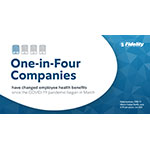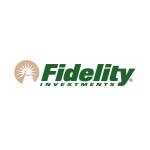Fidelity Reports One-In-Four Companies Have Changed Employee Health Benefits Since COVID-19 Pandemic – Will Working Americans Take Notice?

- While Eight-in-Ten Employees Currently Don’t Plan to Spend Any Extra Time Evaluating Annual Enrollment Options – This is the Year to Take a Closer Look and Stay Informed1
- Fidelity’s 2020 Retiree Health Care Cost Estimate is $295,000 for a 65-Year-Old Couple Retiring in 20202
- Health Savings Accounts (HSA) Are a Valuable Benefit With 89% of Enrolled Employees Reporting Their HSA Has Positive Impact on Their Lives3
BOSTON–(BUSINESS WIRE)–#annualenrollment—Fidelity Investments® , one of the largest and most diversified financial services companies in the world, with industry-leading expertise in delivering benefit solutions that address both financial well-being and health, today issued new employer research finding that one-in-four (27%) organizations have changed employee health benefits since the COVID-19 pandemic began in March4. Given these changes and the amplified importance of maintaining physical, mental and financial health, this year’s annual enrollment marks a critical moment when employees need to spend time understanding and evaluating their options. Yet, 79% of employees don’t anticipate spending extra time evaluating benefits this year compared to what they have done in the past5.
“If 2020 has shown us anything – it’s that this is not a typical year and arguably, we are approaching the most important annual enrollment we will ever experience in our lifetime and we cannot simply default our benefits like we may have done in previous years,” said Hope Manion, Chief Health & Welfare Actuary and senior vice president, Fidelity Workplace Consulting. “At Fidelity, we are educating and encouraging our clients and their employees to be planful and spend more time during this year’s annual enrollment reviewing their benefits, learning about all of their offerings, and asking questions. Given so many have experienced financial and health crises this year, now is the time to ensure they don’t overlook benefits that could impact their future health and financial well-being.”
The Fidelity report “Uncovering the real value of the benefits you offer” highlights a set of health and wellness benefits that generate the biggest impact on employees’ overall well-being, ranging from traditional health care and telemedicine to disability insurance and workplace flexibility offerings. According to the research, many employees are generally aware of valuable benefits, but still are not taking advantage of them.
For instance, 92% of employees know whether or not an HSA is offered, but many choose not to opt for a High Deductible Health Plan, which is a requirement to contribute to an HSA. Yet, when the HSA is utilized, 89% report that it has a positive impact on their lives6. HSAs help Americans save for their health care expenses, and they offer a triple-tax advantage7: 1) tax-free contributions; 2) tax-free growth on balances and 3) tax-free withdrawals for qualified medical expenses. Another benefit is that an HSA can be used to pay for today’s health expenses, or it can be invested for potential growth and then used to cover future expenses, such as those in retirement.
To help better educate employees on the importance of planning for health care costs, particularly for those approaching traditional retirement age, Fidelity releases its annual Retiree Health Care Cost Estimate, and this year it’s $295,000 – which is the amount a 65-year old couple retiring this year can expect to spend on health care and medical expenses throughout retirement8. This year’s estimate represents an increase of 18% since 2010, when the amount was $250,000 – but up just 3.5% from last year ($285,000) – as health care cost inflation has started to level.
For single retirees, the 2020 estimate is $155,000 for women and $140,000 for men. Fidelity’s estimate assumes both members of the couple are enrolled in traditional Medicare, which between Medicare Part A and Part B covers expenses such as hospital stays, doctor visits and services, physical therapy, lab tests and more, and in Medicare Part D, which covers prescription drugs.
“While the retiree health care cost estimate has reached an all-time-high at $295,000 – this isn’t about ‘sticker shock’ – this is about helping our clients think through their own health needs and make informed financial decisions about their futures,” said Manion. “Educating employees about these potential costs could help drive smarter choices during annual enrollment about their health plans and a better understanding of the impact opening a health savings account could have on their future financial well-being.”
How to Approach This Year’s Benefits Annual Enrollment
Fidelity works closely with employers to create dynamic benefit programs for their employees, including employee retirement savings, health and welfare benefits, and stock plan services. With many employers making changes to their benefits package, here are some benefits to look out for this fall – when most companies have their annual enrollment:
- Health Insurance: Selecting a health plan is critical during annual enrollment as this is the only time in the year that a plan can be chosen (other than when having a major life event, such as change in marital status or birth/adoption of a child). Employees should consider their personal situation—their finances, family health status, and preferred health care providers and hospitals when choosing health care coverage. Review deductibles and out-of-pocket maximums. In order to take advantage of an HSA, employees must first be enrolled in a High Deductible Health Plan.
- HSA and FSA (Flexible Spending Account): Take the time to review how each of these accounts can be used, eligibility guidelines, and updates to what these tax advantaged accounts may cover, including services like telemedicine and over the counter medications.
- Retirement savings: Since COVID-19, it’s possible that some employers may have reduced or suspended their 401(k) retirement savings plan match9, so make sure to check if any changes were made and consider increasing the contribution if a match was reduced or suspended.
Additionally, other benefits may not require an employee to enroll, but it’s important to know if they are available and to understand the full offering. There are often employer benefits that are overlooked, when in fact they could be quite valuable:
- Telemedicine: Not surprising, but among Fidelity clients, 76% saw an increase in usage since the COVID-19 pandemic. This benefit will continue to be important and employees should understand how it works.
- Employee Assistance Program (EAP): As the pandemic caused many people to experience anxiety, mental health and counseling services, such as those offered through an EAP, saw a 39%10 increase in utilization among clients. This is a benefit that is impactful to employees’ overall well-being when offered11.
- Meditation services: Fidelity research Raising the grade on your benefits finds that meditation can help reduce stress, control anxiety and lengthen attention span, but there is a lack of understanding on the positive impact it can have on overall health.
- Wellness programs: Fidelity finds that wellness programs are very impactful when used, but 30% are unaware if their employer even offers them12.
- Retiree medical: Employees approaching retirement should inquire whether they have access to a retiree medical program to help with health insurance once they retire. Only 55% of those offered this valuable benefit are aware of its availability13.
Additional Resources to Help Address Health Care & Financial Health
Fidelity has more than 70 years of experience in navigating challenges in the benefits space and helping clients confidently make decisions that can result in better health and financial outcomes. Fidelity suggests getting more educated on three key areas as it can help employees inform their decision making when evaluating benefits.
- Understand which benefits offer the most value when used according to Fidelity’s new report “Raising the grade on your benefits”
- Leverage the power of HSAs with “3 healthy habits for health savings accounts” “5 ways HSAs can fortify your retirement”and A Year in the Life of an HSA on www.fidelity.com/hsa
- Plan for future health care costs; this is even more important for those close to retirement
About Fidelity Investments
Fidelity’s mission is to inspire better futures and deliver better outcomes for the customers and businesses we serve. With assets under administration of $8.3 trillion, including discretionary assets of $3.3 trillion as of June 30, 2020, we focus on meeting the unique needs of a diverse set of customers: helping more than 32 million people invest their own life savings, 22,000 businesses manage employee benefit programs, as well as providing more than 13,500 institutions with investment and technology solutions to invest their own clients’ money. Privately held for more than 70 years, Fidelity employs more than 40,000 associates who are focused on the long-term success of our customers. For more information about Fidelity Investments, visit https://www.fidelity.com/about-fidelity/our-company.
Keep in mind that investing involves risk. The value of your investment will fluctuate over time and you may gain or lose money.
Investing in bonds involves risk, including interest rate risk, inflation risk, credit and default risk, call risk, and liquidity risk.
Fidelity Brokerage Services LLC, Member NYSE, SIPC 900 Salem Street, Smithfield, RI 02917
939558.1.0
©2020 FMR LLC. All rights reserved.
1 Fidelity Investments, SPECIAL REPORT: Fidelity Participant Well-Being Amid COVID-19, June 2020, n=479
2 Estimate based on a hypothetical couple retiring in 2020, 65-years-old, with life expectancies that align with Society of Actuaries’ RP-2014 Healthy Annuitant rates with Mortality Improvements Scale MP-2016. Actual assets needed may be more or less depending on actual health status, area of residence, and longevity. Estimate is net of taxes. The Fidelity Retiree Health Care Cost Estimate assumes individuals do not have employer-provided retiree health care coverage, but do qualify for the federal government’s insurance program, Original Medicare. The calculation takes into account cost-sharing provisions (such as deductibles and coinsurance) associated with Medicare Part A and Part B (inpatient and outpatient medical insurance). It also considers Medicare Part D (prescription drug coverage) premiums and out-of-pocket costs, as well as certain services excluded by Original Medicare. The estimate does not include other health-related expenses, such as over-the-counter medications, most dental services and long-term care.
3 Fidelity Investments, Uncovering the real value of the benefits you offer, May 2020
4 Fidelity Investments, COVID-19 Influence: Employer Benefits, survey of 293 plan sponsors, June 2020
5 Fidelity Investments, SPECIAL REPORT: Fidelity Participant Well-Being Amid COVID-19, June 2020, n=479
6 Fidelity Investments, Uncovering the real value of the benefits you offer, May 2020
7 With respect to federal taxation only. Contributions, investment earnings, and distributions may or may not be subject to state taxation. The triple tax advantages are only applicable if the money is used to pay for Qualified Medical Expenses as described in IRS Publication 969.
8 Estimate based on a hypothetical couple retiring in 2020, 65-years-old, with life expectancies that align with Society of Actuaries’ RP-2014 Healthy Annuitant rates with Mortality Improvements Scale MP-2016. Actual assets needed may be more or less depending on actual health status, area of residence, and longevity. Estimate is net of taxes. The Fidelity Retiree Health Care Cost Estimate assumes individuals do not have employer-provided retiree health care coverage, but do qualify for the federal government’s insurance program, Original Medicare. The calculation takes into account cost-sharing provisions (such as deductibles and coinsurance) associated with Medicare Part A and Part B (inpatient and outpatient medical insurance). It also considers Medicare Part D (prescription drug coverage) premiums and out-of-pocket costs, as well as certain services excluded by Original Medicare. The estimate does not include other health-related expenses, such as over-the-counter medications, most dental services and long-term care.
9 Fidelity Investments, based on survey of 914 plan sponsors as of April 16, 2020
10 Fidelity Investments, COVID-19 Influence: Employer Benefits, survey of 293 plan sponsors, June 2020
11 Fidelity Investments, Uncovering the real value of the benefits you offer, May 2020
12 Ibid
13 Ibid
Contacts
Corporate Communications
(617) 563-5800
fidelitycorporateaffairs@fmr.com
MeeJin Annan-Brady
(201) 915-8219
meejin.annan-brady@fmr.com
Michelle Tessier
(201) 915-7470
michelle.tessier@fmr.com
Follow us on Twitter @FidelityNews
Visit our online newsroom

